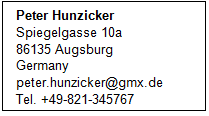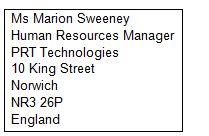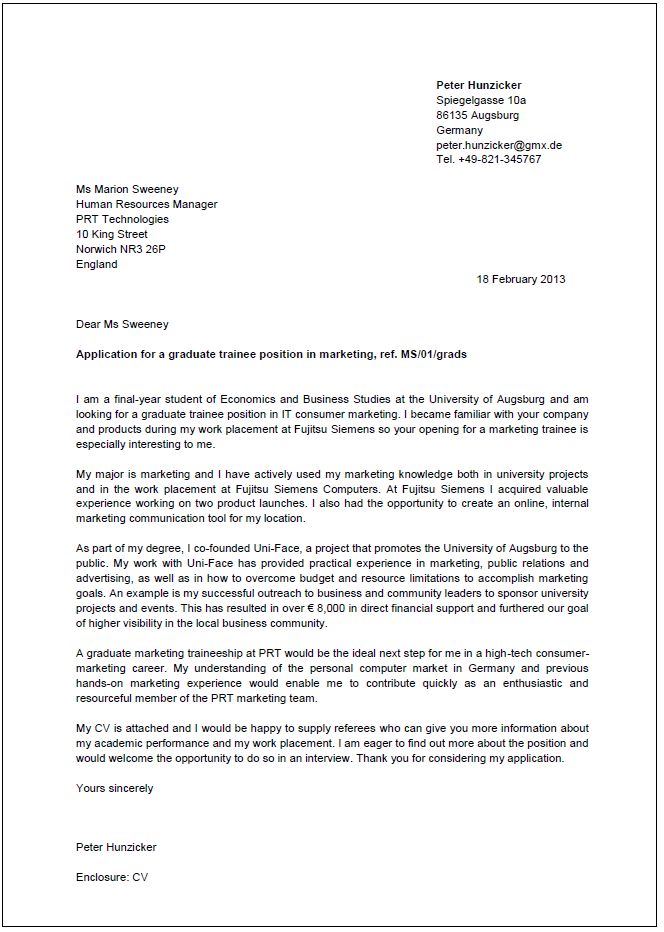Step-by-step guide to a successful cover letter
Introduction
The next few sides will provide you with a step-by-step guidance of how to write and compose a cover letter. The examples on each side are taken from the Cover Letter by Peter Hunzicker. Click on the picture below to get the full-sized Cover Letter to recheck while reading through the instructions.
Click here for a pdf-version and a word document of this section.
Step 1: Your address

- Use the English name for your city, if there is one and the English name for the country.
- Write your name in 14 point bold type so they can find you quickly in a stack of cover letters.
- Don’t use German characters. Write Str. or Strasse.
- Use the (+) sign instead of 00 before the country code for Germany (49). International access codes differ.
- Use a serious email address: badboy@gmx.de isn’t the image you want.
Step 2: Inside address or recipient’s address

- Use their full name with title (Dr, Mr, Ms, Professor).
- In English we don’t combine titles such as Ms doctor or Doctor Professor.
- In business, it is not common for a person to use an academic title.
- Include the person’s position, if you know it.
- Write the full mailing address of the company or institution.
Date may be positioned left or right.
UK: it is written day (number) month (written out) year without commas, e.g. 4 July 2014
US: the order is month (written out) day (number) followed by comma then year, e.g. July 4, 2014
These are small differences and both are understandable and acceptable
Don’t use abbreviations after the day: 21st, 2nd, etc.
Step 3: Salutation and subject line

Dear Ms Smith for a woman and Dear Mr Smith for a man in business. Use academic titles for universities and research facilities. If it is impossible for you to find out the name of the person you should write to, use ‘Dear Sir or Madam’.
The subject line (in Bold) enables the reader to quickly see what your letter is about. Include the position you are applying for, date of the advertisement, source: publication or website and any reference number.
If you are writing to a company that has not posted an opening (unsolicited application), the subject line should contain the type of position you are interested in and the department ‘Application for a summer internship in marketing’.
Step 4: Body
- The body of the letter should consist of three to five short, concisely written paragraphs.
- Leave a blank line between each paragraph.
- Align your letter along the left margin of the page.
- Remember not to use contractions (I’m, don’t, etc.), slang or casual language that you would use in emails to friends.
- Do use action verbs to describe your experience.
Start the opening paragraph with a capital letter.
- Introduce yourself and specify the job you are applying for.
- Briefly explain how you heard about the job and why you are interested in it.
- Following paragraph(s): Expand on the qualifications and experience in your CV to highlight your achievements and strengths. See The first steps to successful applications and interviews.
- Use your research to demonstrate you know something about the company, their industry and the job requirements.
- Show them the connection between what they are looking for and what you have to offer.
- Use, but don’t overuse, key words from the advertisement.
Step 5: Final paragraph

- Restate your enthusiasm for the position.
- Indicate your interest in an interview and your availability.
- Offer to provide additional information and references.
- Thank them for their time and consideration of your application.
- Common phrases such as ‘I look forward to hearing from you soon’ can seem a little obvious and possibly demanding to recruiters who are trying to work their way through hundreds of applications.
Step 6: Complimentary close

- If your letter is addressed to a specific person, use ‘Yours sincerely’ (UK). If you had to start your letter with ‘Dear Sir or Madam’, then close with ‘Yours faithfully’
- In the US ‘Sincerely yours’ or ‘Sincerely’ is appropriate for any business letter.
Step 7: Signature and enclosure

- For an email cover letter, type your full name. For one that is mailed, type your full name, leaving space above for your signature. Include (Mr) or (Ms) - in brackets - before your typed name if it is not clear whether your name refers to a man or a woman. Otherwise, leave it out.
- Use ‘Enclosure’ or ‘Enclosure: CV’ to note the CV you are enclosing with your cover letter. Writing ‘CV’ alone is not enough.
- Be sure your font and font size match your CV and that both are printed on good quality white paper.


